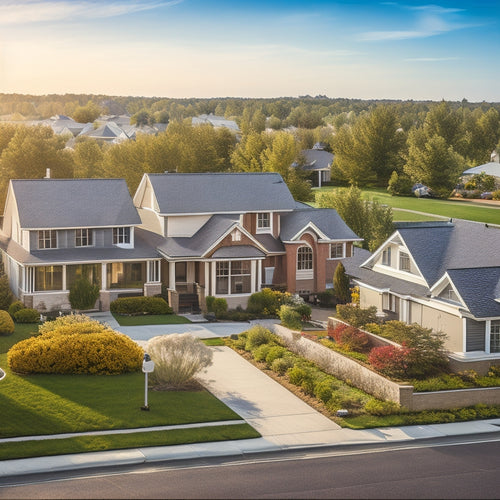
3 Essential Steps for a Successful Roof Solar Panel Installation
Share
You'll need to take three vital steps to guarantee a successful roof solar panel installation. First, assess your roof's readiness by verifying its condition, inspecting for damage, and evaluating sunlight exposure. Next, select ideal solar panels by determining your energy needs, researching types, and evaluating warranties. Finally, guarantee a safe installation by obtaining necessary permits, preparing safety equipment, and implementing mitigation measures to address potential hazards. By following these steps, you'll be well on your way to a successful installation - and optimizing your energy output requires careful attention to these vital details, which we'll investigate further.
Key Takeaways
- Assess the roof's condition to ensure it can support the weight and durability of solar panels.
- Select ideal solar panels based on energy efficiency, type, warranty, and durability to meet energy needs and budget constraints.
- Ensure a safe installation by obtaining necessary permits, preparing safety equipment, and implementing hazard mitigation measures.
- Conduct a shading analysis to evaluate sunlight exposure on the roof and identify nearby obstructions.
- Consult professionals for a thorough assessment and installation to ensure optimal energy output and compliance with legal requirements.
Assess Roof Readiness
You're about to commence a significant investment in your home's energy efficiency, and it's vital to verify your roof is ready for solar panels. Before installation, it's important to assess your roof's condition to guarantee it can support the weight and durability requirements of solar panels.
Conduct a thorough inspection to identify any damaged, rotten, or missing shingles, curled or buckled shingles, and signs of wear around chimneys, vents, and skylights.
Next, perform a shading analysis to determine the amount of sunlight your roof receives. This involves evaluating the surrounding environment, including nearby trees, buildings, and other obstructions that may cast shadows on your roof.
A shading analysis will help you determine the best placement of solar panels to maximize energy production. Consider consulting with a professional to guarantee a thorough assessment, as a poorly installed system can lead to reduced energy output and a lower return on investment.
Select Ideal Solar Panels
With numerous solar panel options available, selecting the ideal ones for your roof can be a challenging task. You need to take into account several factors, including your energy needs, budget, and roof size.
Start by determining the energy efficiency you require from your solar panels. Look for panels with high energy efficiency ratings, typically above 20%. This guarantees you generate the most power from the available roof space.
Next, research different solar panel types, such as monocrystalline, polycrystalline, and thin-film. Monocrystalline panels offer high energy efficiency but are more expensive. Polycrystalline panels are a more affordable option with slightly lower energy efficiency. Thin-film panels are the most budget-friendly but have lower energy efficiency.
Take into account the warranty and durability of the solar panels. Look for panels with a warranty of at least 25 years and a proven track record of performance.
Ensure Safe Installation
Selecting the ideal solar panels is just the first step in a successful installation. Now, it's time to guarantee a safe installation. You'll need to obtain the necessary installation permits from your local authorities, which will vary depending on your location.
Make certain you understand the requirements and comply with them to avoid any legal issues.
Next, prepare the necessary safety equipment, such as safety belts, ropes, and hard hats, to protect yourself and your team from potential risks.
You should also confirm that your team is properly trained to handle the equipment and maneuver the rooftop safely.
It's vital to identify potential hazards, such as loose tiles or weak structures, and take measures to mitigate them.
Frequently Asked Questions
Can I Install Solar Panels on a Metal or Tile Roof?
You can install solar panels on a metal or tile roof, but you'll need to take into account specific requirements. For metal roofs, verify compatibility with the roofing material and take into account additional structural support. Tile roofs require specialized hooks and flashing to maintain waterproofing.
Are Solar Panels Covered Under My Homeowner's Insurance Policy?
As you bask in the glow of your new solar panels, remember that your homeowner's insurance policy has got you covered - but don't assume it's a blanket coverage; review your policy for solar insurance coverage and policy limitations to avoid any surprises.
How Often Should I Clean My Solar Panels for Optimal Performance?
You should clean your solar panels every 6-12 months for peak performance, as dirty panels can reduce energy output by up to 25%. Regular solar panel maintenance through peak cleaning guarantees you get the most out of your investment.
Can I Install Solar Panels Myself to Save on Labor Costs?
You're exploring uncharted waters by considering a DIY installation, but don't plunge in without a life jacket - safety precautions are essential. While saving on labor costs is tempting, improper installation can lead to system failures, voided warranties, and even electrical shocks, so proceed with caution.
Are There Any Local or State Incentives for Solar Panel Installation?
You'll likely qualify for federal tax credits and renewable energy rebates, which can greatly offset your solar panel installation costs; research your local and state incentives to maximize your savings and get the most bang for your buck.
Conclusion
You've made it to the final step of your roof solar panel installation expedition. Don't let concerns about ROI hold you back - with the right installation, you can start saving money on energy bills and even increase your property value. By following these 3 essential steps, you'll be utilizing the power of the sun in no time. Remember, a successful installation is just a few checks away from a brighter, more sustainable future.
Related Posts
-

Why Go Green With Automotive Products Online?
By switching to eco-friendly automotive products online, you're taking a significant step towards reducing your carbo...
-

Why Electric Motorcycles Fail at Long-Distance Touring
You're likely familiar with the excitement of hitting the open road on an electric motorcycle, but you're also smart ...
-

Why Invest in Residential Solar Panel Systems?
By investing in a residential solar panel system, you'll harness renewable energy, reducing your carbon footprint and...


